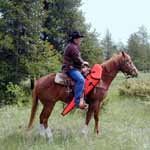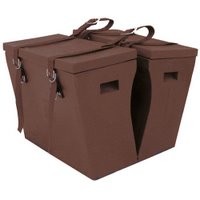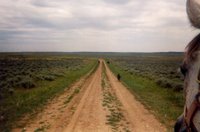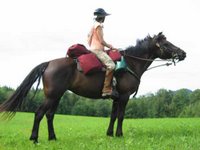There are some easy ways to add orange to your gear so that you can enjoy the backcountry and be seen. The most obvious is to wear orange yourself. An easy way to do this without much additional expense is with an orange safety vest worn over your usual clothes. Orange hat and helmet covers are also available.
The next way is to put orange on your horse. Get some orange on his head with an orange halter, like the TrailMax Packer’s Halter. Wrap his neck with an orange neck wrap.
 Tie orange safety ribbon in his tail. If you use leg wraps or sports medicine boots on your horse, get a pair in orange or another loud color.
Tie orange safety ribbon in his tail. If you use leg wraps or sports medicine boots on your horse, get a pair in orange or another loud color.Another way to add orange is to get orange saddle accessories. TrailMax Horse Saddlebags and horn bags are offered in orange in both original and junior sizes. In fact the entire line of TrailMax products are available in orange for your safety.
If you are a packer, orange gear is readily available. Ralide-West HorsePac and ProPac panniers are both available in orange. TrailMax Decker Style and Sawbuck Style Top Packs are also available in orange. We also offer an orange pack pad from Diamond Wool.
Already have your packing equipment in another color? That’s OK. The TrailMax Packer’s Rain Cover is available in orange. It will protect your entire load from inclement weather and make you extremely visible.
 Hunters…want to add some additional orange to your set up? The Guardian Rifle Scabbard is offered in orange. Protect your scoped hunting rifle and yourself at the same time.
Hunters…want to add some additional orange to your set up? The Guardian Rifle Scabbard is offered in orange. Protect your scoped hunting rifle and yourself at the same time.TrailMax Saddle Panniers and the TrailMax Pack-A-Saddle are both available in orange. Use your western riding saddle as a pack saddle with either type of saddle panniers. Ride in and pack out and BE SEEN doing it.
Here in Montana (and in many other areas of the country as well I am sure), fall is one of the most beautiful times of the year to be in the backcountry. There is no reason not to enjoy it, with a couple extra precautions. And it is easy to be safe if you are willing to BE SEEN.






 I'm carrying about 42 pounds in my saddle bags-12 pounds in front, when my water bottles are full- and 30 pounds in back. I've packed a tent, sleeping bag, airflow mattress, D-cell battery fence charger, 4 fence poles cut into 3 pieces with connectors attached, 4 insulators and enough hot tape to make a small 25 x 25 paddock, first aid equipment for both Jolie and I, toiletries, leatherman, headlamp, pepper spray, rain poncho, really good rain pants and jacket, portable water bucket, tape recorder and notebook, about 5 pounds of grain, combination curry/brush, hoofpick, mane comb, insect repellent for horse and human, food for me (jerky, nuts, fruit, bread, cheese yogurt, etc. I've been able to replenish my food at the occasional little store I come across, or at the various farms where people have invited me in), 2 pairs of socks, 3 underwear, extra t-shirt and long sleeved shirt, 1 pair of pants and 1 extra horseshoe. I think that's everything. I didn't bring a stove because I just didn't have any more room. The leatherman and headlamp have been
I'm carrying about 42 pounds in my saddle bags-12 pounds in front, when my water bottles are full- and 30 pounds in back. I've packed a tent, sleeping bag, airflow mattress, D-cell battery fence charger, 4 fence poles cut into 3 pieces with connectors attached, 4 insulators and enough hot tape to make a small 25 x 25 paddock, first aid equipment for both Jolie and I, toiletries, leatherman, headlamp, pepper spray, rain poncho, really good rain pants and jacket, portable water bucket, tape recorder and notebook, about 5 pounds of grain, combination curry/brush, hoofpick, mane comb, insect repellent for horse and human, food for me (jerky, nuts, fruit, bread, cheese yogurt, etc. I've been able to replenish my food at the occasional little store I come across, or at the various farms where people have invited me in), 2 pairs of socks, 3 underwear, extra t-shirt and long sleeved shirt, 1 pair of pants and 1 extra horseshoe. I think that's everything. I didn't bring a stove because I just didn't have any more room. The leatherman and headlamp have been
